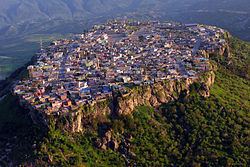Country Iraq Governorate Dohuk Governorate Founded Before 3000 B.C. Local time Monday 4:03 PM | Autonomous region Kurdistan District Amadiya District Elevation 3,900 ft (1,200 m) | |
 | ||
Weather 13°C, Wind S at 6 km/h, 41% Humidity | ||
Amadiya kurdistan town in iraq
Amadiya (Kurdish: Amêdî, ئامێدی, Arabic: العمادية, Aramaic: ܥܲܡܵܕܝܵܐ Al-Emadiyah) is an Assyrian and Kurdish populated town and popular summer resort and Hill station along a tributary to the Great Zab in the Dahuk Governorate of Iraqi Kurdistan. The city is situated 4,600 feet (1,400 m) above sea level.
Contents
- Amadiya kurdistan town in iraq
- Map of Amedi Iraq
- Amadiya once in a place full movie
- History
- Geography
- Climate
- References
Map of Amedi, Iraq
Amadiya once in a place full movie
History
The history of the city of Amadiya goes back as far as ancient Assyria, and it has probably existed even prior to that due to its strategic place on the flat top of a mountain. It was an Ancient Assyrian city known as Amedi from the 25th century BC until the end of the 7th century BC with the fall of the Assyrian Empire. After that, it was part of Achaemenid Assyria, Seleucid Assyria, the Roman province of Assyria, and Parthian- and Sassanid-ruled Assyria (Athura/Assuristan) until its dissolution in the mid 7th century AD after the region's conquest by the Arabs. Then, for several centuries, after the expulsion of the caliphs from Baghdad in the 7th century, it was ruled by a pasha from the royal Abbas family, reputed to be one of the richest families in the region.
The region in which the city rests is believed to have been the seat of the Magi, or high priests of Persian-ruled Assyria, and the city itself is believed to be the home of some of the most significant Magi priests: the Biblical Magi or the "Three Wise Men" who made a pilgrimage to Jerusalem to see Jesus Christ shortly after his birth.
Amadiya was the birthplace of the pseudo-Messiah, David Alroy (fl. 1160). In 1163, according to Joseph ha-Kohen's "'Emeḳ ha-Baka", the Jewish population numbered about a thousand families and traded in gall-nuts. Alroy led a revolt against the city but was apparently defeated and killed in the process. The Spanish Jewish historian R. Schlomo Ibn Verga (1450–1525) portrayed the Jewish community of Amadiya at the time of Alroy as wealthy and contented.
Amadiya was the seat of the semi-autonomous Badinan Emirate, which lasted from 1376 to 1843. At the turn of the 19th century, the population already numbered 6,000, of whom 2,500 were Kurds, 1,900 Jews and 1,600 Assyrians. There are ruins from the Assyrian era and ruins of a synagogue and a church in the small town. The city also has an ancient mosque and a church.
Geography
The town is perched on a mountain, formerly only accessible by a narrow stairway cut into the rock. Amedia has a well-integrated community of Christian Assyrians and Muslim Kurds who share the city and local social events.
Although Amedia is just 10 1⁄2 miles (16.9 km) from the Turkish border across the Beshesh Mountains, the only border crossing into Turkey is now at Ibrahim Khalil border on the road Amedia - Dohuk - Zakho, 56 miles (90 km) away. A border crossing was once at at Habur.
The region north of the mountainous region on the border with Turkey is where poplar, willow, oak, hawthorn, cherry plum, rose hips, mountain apple, pear, Sorbus, and other wild trees and meadow grasses are usually located. The town is 1,100 yards (1,000 m) long and 550 yards (500 m) wide. It houses 6,000 citizens in almost 1,200 houses.
Climate
Amadiya has a hot-summer Mediterranean climate (Csa) with short hot summers and long, cool, wet winters. Being the most northerly city in Iraq, it is the most mildest city in the country.
